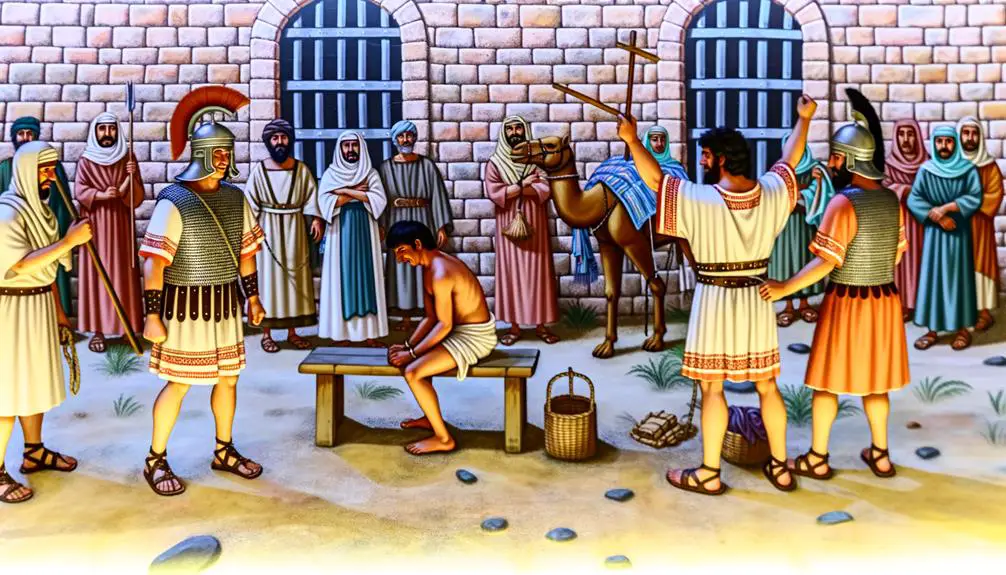Discover how flogging in the Bible symbolizes more than punishment, hinting at deeper spiritual lessons on justice and redemption.

What Does Flogging Mean in the Bible
In the tapestry of biblical narratives, flogging emerges not just as stripes on the back, but as a complex symbol intertwining justice, repentance, and divine command. You'll find its traces across ancient texts, painting a picture that's both punitive and profoundly instructional.
Exploring what flogging meant in the Bible opens up a corridor to understanding how ancient societies navigated the murky waters of sin, punishment, and redemption. What's intriguing is how these ancient principles resonate or clash with modern sensibilities about justice and morality.
Unpacking this could reshape your perspective on punishment's role in spiritual and societal order.
Key Takeaways
- Flogging in the Bible is tied to theological significance, emphasizing atonement and spiritual cleansing.
- Biblical law limits flogging to a maximum of forty lashes, reflecting ancient legal frameworks.
- The practice symbolizes not just punishment but also moral realignment and repentance.
- Interpretations of biblical flogging vary, influenced by translation differences and cultural understandings.
Historical Context of Flogging

In examining the historical context of flogging, it's crucial to recognize that this form of punishment was deeply embedded in ancient legal and societal frameworks, serving as both a method of discipline and a deterrent. You'll find that cultural practices across different civilizations integrated flogging in various forms, each adapting the punishment to fit its unique societal norms and judicial systems. This reveals a universal acknowledgment of flogging's efficacy in enforcing laws and maintaining order.
Delving deeper, it's interesting to note how flogging stood apart from more severe execution methods. Unlike execution, which was often the ultimate penalty for the gravest offenses, flogging served a multifaceted role. It wasn't only punitive but also intended to rehabilitate and reintegrate the offender into society. This distinction underscores the nuanced understanding ancient societies had regarding punishment and correction.
The methodology and instruments used for flogging were also reflective of the intricate cultural and legal considerations of the time. The number of lashes, the type of whip, and the public or private execution of the punishment were all carefully calibrated to match the crime's severity, the offender's status, and the community's moral and ethical standards.
Through this analytical lens, it's clear that flogging was far more than a mere act of violence or retribution. It was a well-integrated component of ancient legal systems, designed with a profound understanding of human behavior, societal order, and the balance between punishment and rehabilitation. Understanding this historical context enriches your comprehension of flogging's significance, both as a cultural practice and within ancient judicial proceedings.
Biblical References Explained

Exploring biblical references reveals that flogging, often mentioned in both Old and New Testaments, holds significant theological and moral implications within the scriptural narrative. This practice, interpreted through various cultural lenses, underscores the importance of understanding the historical and societal context in which these texts were written. Cultural interpretations play a pivotal role in discerning the nuances of flogging, as the perception and application of this punishment have evolved over centuries. In the ancient world, flogging was a common punitive measure, but the reasons and methods varied significantly from one culture to another, influencing how these passages are understood today.
Translation variations further complicate our comprehension of biblical references to flogging. The original Hebrew and Greek texts use different terms to describe the act, each with its own connotations and implications. As these ancient texts have been translated into numerous languages over millennia, subtle shifts in meaning have occurred. These variations can alter our understanding of the severity and purpose of flogging as depicted in the Bible. Scholars meticulously analyze these texts, comparing translations and consulting historical documents to gain a clearer picture of what flogging entailed and represented in biblical times.
In examining these references, you're delving into a complex interplay of language, culture, and history that shapes our interpretation of the scriptures. Recognizing the influence of cultural interpretations and translation variations is crucial in grasping the multifaceted significance of flogging in the biblical context.
Purpose and Significance

Delving into the purpose and significance of flogging within biblical texts offers insights into the complex moral and theological dimensions it embodies. This practice, while harsh by modern standards, was deeply embedded in the cultural fabric of ancient societies. Understanding its role sheds light on the values and norms of the time, as well as offering a lens through which to examine its modern relevance and the evolution of cultural interpretations.
Here are four key points to consider:
- Cultural Context: Flogging, in biblical times, wasn't only a form of punishment but also a means of societal correction. It aimed to maintain social order and discipline within the community by deterring others from committing similar offenses.
- Theological Significance: Theologically, flogging was seen as a way to atone for sins and cleanse the individual. This perspective reflects the broader biblical themes of repentance and redemption, although it's crucial to note that our focus here isn't on repentance directly.
- Modern Relevance: Today, the concept of flogging challenges us to reflect on contemporary methods of discipline and correction. It pushes us to question how societal norms and values have shifted and what that means for our understanding of justice and mercy.
- Cultural Interpretations: Over time, interpretations of biblical texts have evolved. This evolution highlights the dynamic nature of religious teachings and their adaptability to new contexts, prompting ongoing discussions about the relevance of ancient practices in today's world.
Flogging and Repentance

Reflecting on the cultural and theological dimensions of flogging leads us to consider its role in the process of repentance as presented in biblical narratives. The act of flogging, as depicted in these texts, is not merely punitive but is deeply intertwined with the concept of repentance and moral realignment. Through the lens of modern interpretations, this ancient practice invites a complex understanding of its intended psychological impacts and the broader spiritual rehabilitation it signifies.
Aspect |
Biblical Context |
Modern Interpretation |
|---|---|---|
Purpose |
To induce repentance and purification |
Seen as a metaphor for personal transformation |
Method |
Physical flogging |
Psychological introspection and correction |
Outcome |
Spiritual cleansing and restoration |
Enhanced self-awareness and moral realignment |
Psychological Impact |
Immediate and profound |
Long-term introspection and mental realignment |
This table succinctly captures the transition from a physical to a more psychological and spiritual interpretation of flogging within the context of repentance. In ancient times, the act served as a tangible means to demonstrate remorse and a desire to amend one's ways. Today, its significance is often explored through the psychological impacts of guilt, remorse, and the journey towards self-improvement and spiritual renewal.
Understanding flogging through this dual lens allows for a richer comprehension of its place within biblical texts and its relevance to contemporary discussions on morality, punishment, and the human condition. It's a testament to how ancient practices can still inform modern ethical and spiritual dilemmas, urging us to reflect deeply on the pathways to repentance and the nature of transformation.
Legal Frameworks and Limits

While the Bible outlines the spiritual dimensions of flogging, it's also crucial to examine the legal frameworks and limitations that governed its administration in ancient times. The regulations surrounding this practice weren't arbitrary; they were deeply embedded in the cultural and legal norms of the period, providing a fascinating glimpse into ancient justice systems. Understanding these frameworks allows us to see the intricate balance between punishment, repentance, and societal standards.
Here are four key aspects to consider:
- Maximum Stripes: Biblical law specifically capped the number of lashes at forty, a limit meant to prevent excessive punishment and preserve the dignity of the punished individual.
- Public Administration: Floggings were typically carried out in public, serving not just as a punishment but also as a deterrent to others. This transparency ensured that the punishment was witnessed, adding a layer of societal accountability.
- Cultural Variations: Across different cultures and time periods within the Bible, the application and method of flogging varied, reflecting broader societal norms and legal principles. It's a reminder that even within the Bible, practices evolved and adapted to changing contexts.
- Modern Parallels: While the practice of flogging might seem distant, modern legal systems still grapple with finding the balance between punishment and human dignity. Understanding the biblical approach offers insights into the complexities of formulating punishment that aims to correct rather than merely to harm.
Analyzing the legal frameworks and limits of flogging in the Bible not only deepens our understanding of ancient justice but also encourages thoughtful reflection on the principles that guide modern legal practices.
Frequently Asked Questions
How Does Modern Archaeological Evidence Correlate With Biblical Accounts of Flogging?
Modern archaeological methods don't directly prove biblical accounts of flogging, but they give context. By examining artifacts and historical sites, you can understand the society and practices of the time. This indirect evidence can support the cultural backdrop depicted in biblical texts.
What Parallels Can Be Drawn Between the Practice of Flogging in the Bible and Similar Practices in Other Ancient Civilizations?
You'll find that flogging, both in the Bible and other ancient civilizations, served a dual role in cultural rituals and legal systems. This practice wasn't only a form of punishment but also a means to purify or correct behavior within a community.
When comparing these practices, it's evident that many civilizations shared a belief in physical punishment as a tool for maintaining social order and enforcing laws.
How Have Interpretations of Biblical Flogging Changed Over Time Within Different Christian Denominations?
You're exploring how views on biblical flogging have evolved across Christian groups. Denominational doctrines play a key role, as each interprets scriptures through its own theological lens.
Cultural interpretations further diversify understandings, influenced by societal changes and scholarly insights. This dynamic landscape shows a rich tapestry of belief and practice, reflecting on how communities reconcile ancient texts with contemporary values, all while maintaining a respectful and analytical approach to this sensitive topic.
Are There Any Known Health and Psychological Impacts on Individuals Who Underwent Flogging, According to Historical Records or Studies?
Yes, historical accounts and studies indicate flogging had severe health and psychological impacts. Victims faced long recovery periods, often grappling with physical scars and chronic pain.
Psychologically, the resilience of individuals varied greatly. Some developed coping mechanisms to deal with trauma, while others suffered from long-term mental health issues like PTSD.
This evidence underscores the brutal nature of flogging and its lasting effects on a person's well-being.
How Does the Portrayal of Flogging in Contemporary Media Compare With Its Biblical Descriptions and Historical Practices?
Imagine flipping through channels or scrolling through your favorite streaming service. You've probably noticed that the portrayal of flogging varies dramatically.
When comparing contemporary media to historical practices, cinematic accuracy often takes a backseat to media sensationalism. While some films and series strive for historical fidelity, many exaggerate the brutality or frequency of flogging for dramatic effect, distorting its actual significance and application in historical contexts.
Conclusion
In conclusion, flogging, within the biblical context, serves not merely as a form of punishment but as a profound avenue for repentance and societal correction. You've seen how its purpose transcends physical discipline, aiming instead at the moral and spiritual reformation of the individual.
But, doesn't this ancient practice also challenge us to reflect on the nature of justice and redemption? Through its legal frameworks and limits, flogging underscores a delicate balance between justice, mercy, and the possibility of transformation.



Sign up